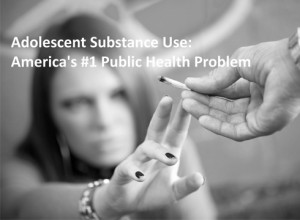Teen substance use is America’s #1 public health problem

Did you know that America’s leading public health problem is adolescent substance use? A new report from the National Center on Addiction and Substance Abuse (CASA) at Columbia University in New York points to statistics that show an epidemic of use among minors. The study states that:
- 75 percent (10 million) of all high school students have used addictive substances including tobacco, alcohol, marijuana or cocaine; 1 in 5 of them meets the medical criteria for addiction.
- 46 percent (6.1 million) of all high school students currently use addictive substances; 1 in 3 of them meets the medical criteria for addiction.
“Smoking, drinking and using other drugs while the brain is still developing dramatically hikes the risk of addiction and other devastating consequences,” said Jim Ramstad, a CASA board member who also chaired the report’s National Advisory Commission.
The CASA report noted that alcohol is the preferred addictive substance among high school students:
- 72.5 percent have drunk alcohol;
- 46.3 percent have smoked cigarettes;
- 36.8 percent have used marijuana;
- 14.8 percent have misused controlled prescription drugs; and
- 65.1 percent have used more than one substance.
 Mr. Ramstad further commented that “The combination of adolescence, an American culture that glorifies and promotes substance use, and easy access to tobacco, alcohol and other drugs creates a perfect storm for our teens and for taxpayers,” said Ramstad. “We no longer can justify writing off adolescent substance use as bad behavior, as a rite of passage or as kids just being kids. The science is too clear, the facts are too compelling, the health and social consequences are too devastating and the costs are simply too high.”
Mr. Ramstad further commented that “The combination of adolescence, an American culture that glorifies and promotes substance use, and easy access to tobacco, alcohol and other drugs creates a perfect storm for our teens and for taxpayers,” said Ramstad. “We no longer can justify writing off adolescent substance use as bad behavior, as a rite of passage or as kids just being kids. The science is too clear, the facts are too compelling, the health and social consequences are too devastating and the costs are simply too high.”
The CASA report contains a full list of recommendations that include:
- Educating the public that teen substance use is a public health problem and addiction a medical problem that in most cases originates in adolescence.
- Preventing or delaying the onset of substance use through effective public health measures.
- Identifying teens most at risk through routine screenings.
- Intervening early to prevent further use and consequences as with any other public health problem.
- Providing appropriate medical treatment to teens for substance use disorders.
A report from the Partnership at DrugFree.org that was published in May, 2012, indicated that abuse of prescription drugs among teens declined slightly in 2011, but increased when it comes to the use of marijuana. The percentage of teens smoking pot at least twenty or more times a month went from 5% in 2008 to 9% in 2011. Teens who reported using prescription pain medication (Vicodin and Oxycontin) declined one percent from a high of 15% in 2009 to 14% in 2010.
If you have a problem with alcohol, pills or other substances do you know what to do if you want to stop and take back control over your life? Are there AA (Alcoholics Anonymous), NA (Narcotics Anonymous), or CA (Cocaine Anonymous) programs for teens in your community? Is there someone in your life that you trust and can speak to about this? Try your parents first and if you’re uncomfortable approaching them, seek out another responsible, trusted adult. Some states allow minors to get drug counseling without a parent’s consent.
Take a look at this White House website for information about drug use and treatment.
Here’s another resource for ages 11 to 15 that provides science-based facts about how drugs affect the brain and body. The site uses animated illustrations, quizzes and games.
Update: A study from the University of Otago in New Zealand was released in September, 2012, regarding the effect of marijuana use on one’s IQ. The findings indicated that teenagers who routinely use marijuana risk a long-term drop in their IQ. Those who started using the drug before age 18 were followed for twenty-five years and showed signs of harm to the developing brain. Surprisingly, those that stopped using marijuana after turning 18 didn’t remove the problem.



